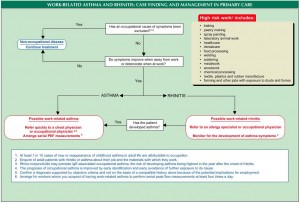Canadian Health and Care: Diagnosis and Management of Work-Related Asthma
Clinical Course
Our patient was treated with systemic corticosteroids and had rapid resolution of the rash and pulmonary infiltrates (Fig 5). All culture findings were sterile. The patient underwent a bone marrow biopsy, and the findings were consistent with a myelodysplastic syndrome. Subsequently, a cutaneous recurrence of Sweet syndrome developed during tapering of systemic corticosteroid. Four months after the initial diagnosis, the patient underwent allogeneic stem-cell transplantation but later died of multisystem organ failure.
Clinical Pearls
1. Acute febrile neutrophilic dermatosis (Sweet syndrome) is a well-recognized clinical entity with a diverse clinical spectrum that not only includes characteristic dermatologic manifestations but also may present with extracutaneous involvement of almost any organ system. 
2. Criteria have been established to aid in the diagnosis of Sweet syndrome, which include a combination of clinical, pathologic, and laboratory findings, as well as response to treatment with corticosteroids.
3. If the diagnosis of Sweet syndrome is made, it should be classified as classical (idiopathic), malignancy associated, or drug induced, and the potential for associated clinical conditions should be recognized based on this classification.
4. Extracutaneous manifestations can involve a variety of organ systems, and if pulmonary involvement is noted an underlying hematologic dyscrasia is more likely to be an associated clinical condition.
5. Due to the fact that treatment with corticosteroids typically induces rapid improvement, Sweet syndrome should be promptly recognized in order to provide timely treatment and potentially prevent clinical deterioration.
Background: A previous American College of Chest Physicians Consensus Statement on asthma in the workplace was published in 1995. The current Consensus Statement updates the previous one based on additional research that has been published since then, including findings relevant to preventive measures and work-exacerbated asthma (WEA).